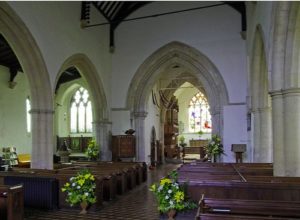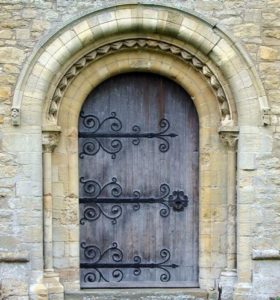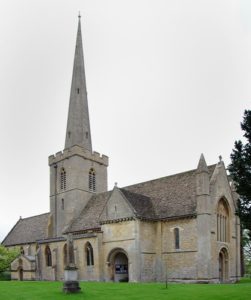Bredon is an attractive small village of stone and timber frame houses on the banks of the River Avon, just north of Tewkesbury. It is a lovely rural setting on the lower slopes of Bredon Hill with its ancient hill fort.
This was the site of a Saxon Monastery dedicated to St Peter, which was probably burnt by the Danes. The present building was started at the end of the C12th when a nave, tower and small chancel was built. The south aisle was added in the C13th. The north aisle was added in the C14th when the tower was rebuilt with its spire and a much larger chancel.
The church is at the western edge of the village and set in a large walled churchyard. It is an attractive building with a tall slender spire and corbel shelf around the top of the nave. The nave is still the Norman building and has beautiful Norman doorways with chevron carvings at the west end and on the south porch.
Inside it is a large church with very wide nave and quite short side aisles. Pillars with pointed arches form an arcade on either side. Walls are whitewashed and there is a simple wood beam ceiling. At the back of the nave are two of the original small Norman windows. Above the north doorway is a small wooden door giving access to the room above the porch. This would have been reached by a ladder and may have been library, strong room or simply a room used by a visiting priest.
At the back of the church are boards with the Ten Commandments, Lords Prayer and Creed. On the west wall are two benefice boards. That listing gift to the school makes interesting reading with all the conditions set down.
The Royal Coat of Arms is at the back of the North aisle. The font is at the east end. On the wall behind is a small panelled reredos with a painting of Mary and Jesus in the centre.
The south aisle has three tomb niches in the south wall. Two are abbots who were in charge of St Peter’s Priory in the interim period between the church being built in 1190 and the installation of the first rector in 1236. At the east end, the tomb slab has a shield with two arms holding a heart. According to tradition, this is a crusader tomb containing the heart of a knight from Bredon, possibly Sir Nicholas de Milton d1290. He was killed while on crusade and his body was buried in the Holy Land, but his heart was brought back for a Christian burial.
On the west wall is the splendid alabaster and black marble tomb of Sir Giles and Lady Catherine Reed who did in 1611. At their feet and feet are the kneeling figures of their children. The tomb is set under a rounded arch picked out with gold. Black marble pillars support a portico above with their coat of arms. There are obelisks, putti and an eagle.
At the end of the nave is a pointed, Transitional style arch with chevron carving and supported on columns with scallop capitals. The chancel is very long and the north side is taken up by a large organ. The steps up to the sanctuary are faced with medieval tiles. On the south wall is a three seater sedilia and piscina. The east window above the altar contains C19th glass with scenes of the Nativity and the three kings.
At the end of the south wall of the chancel by the sanctuary steps is the tomb of William and Katherine Reed and their small child, who lies on the far side of them, next to the wall. He is wearing a long surcoat and sword with his feet resting on a lion. Over them is a lovely carved canopy.
In the sanctuary next to it s an early C14th coffin lid. At the top set under trefoliate arches are two heads which may be early members of the Reed family. Below is Christ crucified on a cross of thorns, with two doves above his head.
On the opposite wall is the Easter Sepulchre. This is an early wall tomb set under a pinnaceled ogee arch. The simple hog back tomb slab is covered with ball decorations. The cross from the high altar and the Blessed Sacrament were placed here from Good Friday until the morning of Easter Sunday, as a representation of the Resurrection of Christ.
This is a very attractive church. It is impressive from the outside and just as good inside. It is a large, light and friendly church and definitely worth visiting.
The church is open daily and there is parking in the lane by the lych gate.










